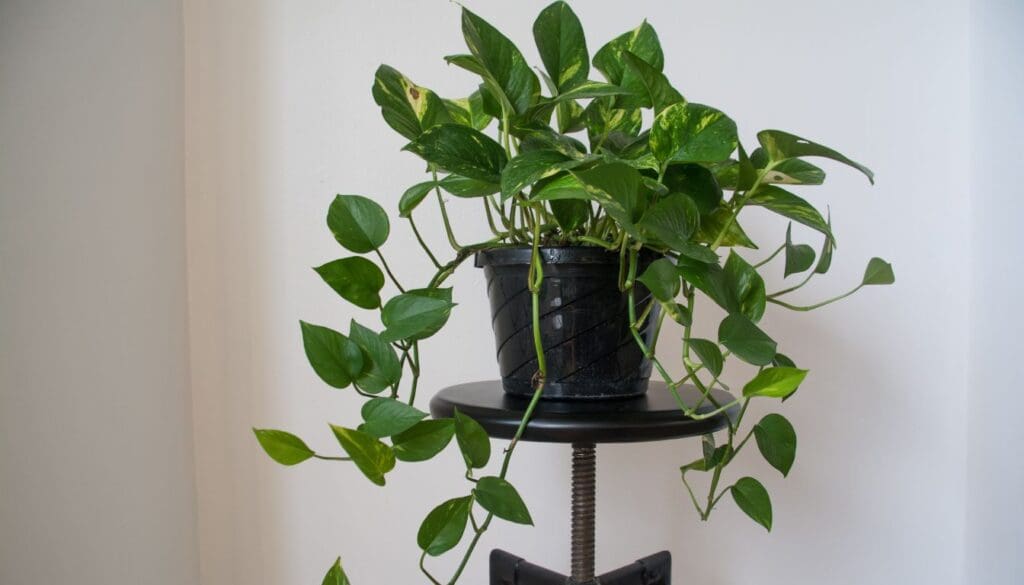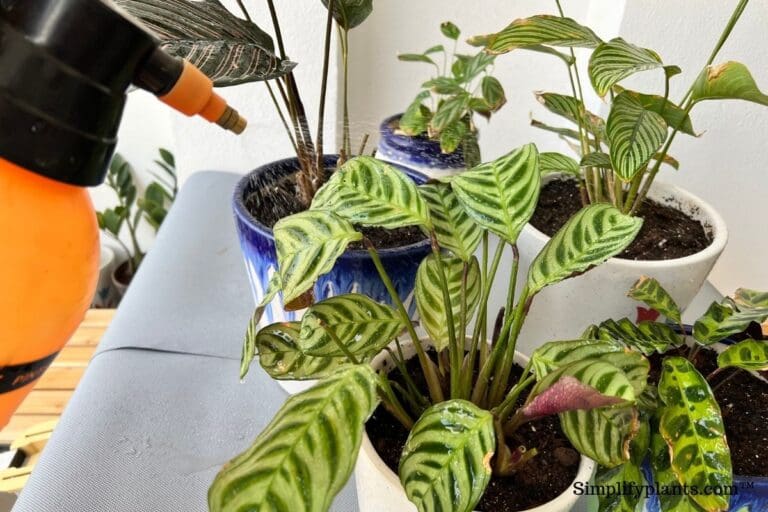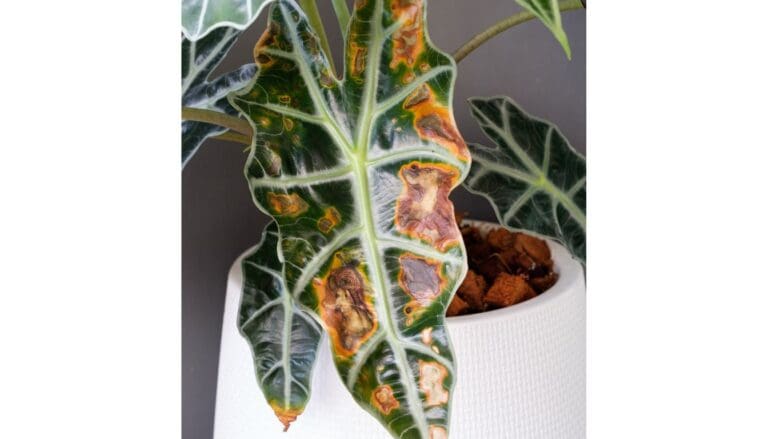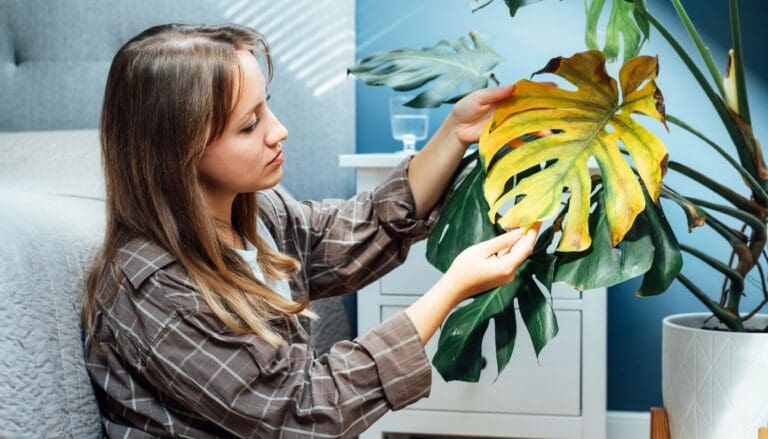How Much Light Do Pothos Need? (+All Other Lighting Questions)
Pothos is resilient and a beginner-friendly plant. Despite being a low-maintenance plant, plant parents try to provide the best growing conditions. Today, we will talk about the best light conditions for Pothos.
Pothos need 10-12 hours of bright indirect sunlight. It can also survive under low light conditions but not dark corners. The best place is 2-3 ft. from an east-facing window or 5-10 ft. from the south- or west-facing windows.
When Pothos loses its vibrance and vigor, lighting issues are mostly to occur. I have been gardening for 12 years, and Pothos is my favorite. Here, I will explore the optimum light conditions I have maintained for Pothos, the telltale signs of incorrect light conditions, and how to adjust them.

Please note: Simplify Plants is reader-supported. Some links in the post are affiliate links and I get a commission from purchases made through links in the post.
Understanding Pothos light requirements
In their natural habitat, Pothos grow under large tropical plants.
As it grows under the dense canopy, Pothos receives medium to bright indirect sunlight through the leaves.
Since these understory vining plants are adapted to such light conditions, they are destined to become houseplants.
Let’s understand the ideal light conditions for Pothos in detail.
Pothos thrive under bright and indirect sunlight
When you grow Pothos as an indoor plant, you must provide bright and indirect or filtered sunlight throughout the day.
Some newbies get confused about indirect or filtered sunlight. Let me elaborate.
If your Pothos is getting light, but you don’t see direct sunlight on its leaves, that’s indirect sunlight.
If your window has curtains, sun rays pass through the curtain, get filtered, and then reach your Pothos.
It won’t be getting the direct rays but filtered or indirect rays of the sun. That is what it needs.
Pothos low light tolerance
Indeed, Pothos thrive under bright indirect sunlight but can also adapt to low lights.
Pothos’s ability to thrive in low light conditions makes it ideal for dimly lit house corners.
One of my readers emailed me about her Pothos’s slow growth and showed me a picture of it.
Her Pothos was under low light conditions which reduced the growth. However, it was doing fine.
I told her the reason and suggested she shift her Pothos to a brighter location for faster growth.
While Pothos can grow well under low light conditions, their growth will be slower than those under bright indirect sunlight.
Sometimes, the leaf color and patterns might not be very bright or prominent in variegated Pothos, like Snow Queen or Marble Queen Pothos, under low lights.
Can Pothos grow under artificial lights?
Pothos can be an excellent option to brighten up the windowless corner of your house or office. But what about lights?
Though a natural light source is best for Pothos due to its full spectrum, artificial lights are equally suitable for gardeners who don’t have access to windows facing the right direction.
Bright enough light is sufficient for your Pothos.
Jade Pothos can thrive under low light, and their pigmentation gets the most from a small light dose.
You can use Grow lights designed explicitly for Pothos or any light source that provides 10,000 to 20,000 lux.
LEDs and full-spectrum fluorescent lights are good options.
Keep the light at least 12 inches from your Pothos and let it on for around 12-14 hours. Please turn it off after that.
What about direct sunlight on Pothos?
Pothos will get sunburns when exposed to direct sunlight.
However, there is an exception.
Pothos can tolerate direct sunlight in the early morning.
It is gentle and good for photosynthesis and chlorophyll.
Remove your Pothos from direct sunlight after a few hours when the intensity increases.
Optimal light duration and intensity for Pothos

Once you have learned the light conditions, you must understand the intensity and duration to create a perfect light condition for Pothos.
Pothos will need around 10-12 hours of sunlight per day for their best growth.
If not this much, at least 6-8 hours of bright indirect sunlight is mandatory.
The light intensity is measured by lux or lumens per square.
Generally, Pothos should receive 10,000 to 20,000 lux of light daily.
However, Pothos can also survive a wide range of light levels.
Here’s a small list of different light intensity Pothos can tolerate:
- Pothos thrive at 465 to 2,000-foot candles (5,000-21,500 lux) of light for 10-12 hours daily. It is the intensity for medium to bright light conditions.
- Pothos stock plants can tolerate around 5,000 foot-candles (53,800 lux). This intensity falls under direct sunlight. While Pothos can tolerate this in the morning, move it away after 3-4 hours to reduce sunburns.
- For the lower end of the spectrum, Pothos will survive with light intensity below 300-foot candles (3,200 lux) but with a slow growth rate.
To ensure optimal growth, I expose my Pothos to bright indirect sunlight, ranging from 930 to 1,860-foot candles (10,000-20,000 lux) or 745 to 1,490-foot candles (8,000-16,000 lux) in spring and summer.
One of my readers asked me to suggest light intensity for Pothos because he wanted it to grow gradually under low lights.
For this case, I suggest light intensity of around 200 to 400-foot candles (2,152-4,305 lux).
Things to consider while choosing a location to give Pothos optimum light conditions
While choosing the right location for your Pothos, consider a few things:
Light Diffusion for Pothos
Whatever location you choose, light diffusion is essential.
This means there is an object between your Pothos and the light.
The object might be a window, a sheer curtain, or blinds. These things limit the light intensity and reduce the chances of sunburn.
Importance of sky view for Pothos
The sky view also impacts the light quantity for your Pothos.
Suppose you have any obstructions, like awnings, trees, buildings, or furniture near the window where your Pothos is staying.
When these obstructions block the sky view, it reduces the light, making your Pothos receive the least sunlight.
So, remove the obstruction or find a window without these obstructions.
Distance between your Pothos and the window

The distance between the window and your Pothos also affects the light conditions.
The greater the distance, the less the sun’s intensity.
Too close to the window can provide excessive sun exposure and burn the leaves.
However, being too far from the window may result in leggy growth or yellow leaves due to insufficient natural light.
A reasonable distance can make a huge difference.
Generally, I recommend maintaining at least 1-3 feet of distance between the window and the plant.
If the sunlight is too much, maintain 5-10 feet of distance to reduce burns.
Summer vs. Winter lighting for Pothos
The light intensity of Pothos will vary based on seasons.
The days are longer and brighter in the summer with scorching sun rays.
On the contrary, winters have reduced light levels and intensity.
East-facing windows are perfect for Pothos in the summer.
South and west windows also work, but put your Pothos a few feet away or use sheer curtains to reduce sunburns.
On the other hand, move your Pothos to a window with maximum light, like the south or west, in winter.
Don’t worry about the intensity because it is relatively lower in winter.
Finding the right location for optimum light conditions for Pothos
You need to find the right location inside your house to let Pothos have the optimum sunlight.
Though you can use artificial lights, with the right location that receives perfect lighting, you don’t have to invest in the Grow lights.
Let’s understand the different window directions and the light type they provide:
South-facing windows
South-facing windows provide maximum sunlight.
Keeping Pothos near the window can lead to sunburns.
You can still use this window by setting up sheer curtains or Venetian blinds to filter the sunlight or keeping Pothos 8-10 ft. away from the window.
West-facing windows

West-facing windows provide bright, gentle sunlight in the morning but harsh and sweltering sunlight in the afternoon, increasing sunburn risk in Pothos.
You can keep your Pothos near this window but put up sheer curtains or Venetian blinds in the afternoon.
East-facing windows
East-facing windows receive bright morning light and are shaded from the intense afternoon sun, thus making them an excellent option for Pothos.
Here, you don’t have to install curtains or Venetian blinds.
For the best results, you can provide some supplemental LED lighting in the afternoon or evening.
North-facing windows
North-facing windows receive the least sunlight, or lowlights where Pothos will survive but won’t perform at its best.
Pothos will get consistent and evenly distributed light.
However, the plant won’t grow as fast as those in bright areas.
What happens when Pothos is exposed to direct sunlight?
Pothos are naturally grown under the canopy of large tropical plants.
The sunlight they receive penetrates through the plant leaves.
Direct sun rays will make Pothos suffer from leaf burns.
Primarily, the lightened areas get burnt because they don’t have enough chlorophyll to protect themselves from the bright sunlight.
Signs of too much sunlight in Pothos

The common signs of Pothos getting too much sunlight are:
- Pale yellow or brown leaves at the tips and edges indicate scorching.
- Loss of leaf variegation
- Wilting during the hottest hours
- Leaves curling away from the light source to protect themselves from the direct sun
- New growth is thicker with bleached leaves
- Compact and stunted growth because Pothos is too shocked to photosynthesize under the bright sun
What to do when Pothos is getting sunburnt?
Once you have noticed the signs of sunburns in Pothos and confirmed the issue, here’s what you can do:
- Remove your Pothos immediately, 8-9 ft., away from the window.
- Put up sheer curtains or Venetian blinds for light diffusion. It will reduce the intensity and leaf burns.
- Prune the discolored leaves.
- Increase watering your Pothos a bit to let it cool down. It can aid in faster recovery when the leaves are burnt.
- Observe your Pothos and see for signs of recovery.
Pothos are not getting enough sunlight
Pothos thrive best under bright indirect sunlight but can tolerate low lights.
However, dark corners with no light source are not suitable.
Some natural or artificial lights are required for the plant to grow well.
Lack of sunlight makes the plant weak and slows down its development.
Signs of too little sunlight in Pothos
Here are some telltale signs of Pothos getting very little sunlight:
Weak and small eaves
- Leaves losing their variegation due to reduced chlorophyll production
- Slow growth
- Vines have a leggy appearance with extended internodes in search of light
- Pothos is leaning and stretching toward the light source
- Pothos have low energy due to low lights; hence, they drop leaves to reduce the load and feed fewer plant parts.
- Soil takes time to dry out.
How to adjust the light conditions for Pothos?
- Move your Pothos to a brighter location. Consult the different window directions I have mentioned earlier.
- Prune the discolored leaves and leggy growth from your Pothos.
- Use artificial lights if you don’t have any access to a brighter window. LEDs are better as they don’t shatter, use less electricity, and last longer.
- Reduce watering for some time, as Pothos will take time to dry out in the darkness. Let the top few inches dry before watering.
Checking and ensuring optimum light levels for Pothos

To create a perfect light condition for Pothos without letting them suffer from any light-related issues, measure the light levels before finalizing a spot.
There are three ways to check and ensure that the light conditions you have given to your Pothos are ideal for them:
Try a hand shadow test to understand the light levels for Pothos
Set up the spot you have chosen for your Pothos and lay a sheet of paper.
Hold your hand 1 foot above the paper.
Notice the shadow and feel the sun’s heat to test the intensity.
If the shadow seems sharp and the heat is too intense, it is too much for Pothos.
But it is perfect if the shadow is soft and the sun’s rays are bearable.
It is low light if you faintly see a shadow or no shadow. Pothos will survive but grow slowly.
Use a Lux meter to measure the light levels around Pothos
For a more technical method, use a lux meter to measure the light intensity for Pothos.
I suggest buying a lux meter if you have multiple tropical plants that enjoy indirect sunlight like mine.
Lux, presented in lumens per square meter, is a scientific measure of the light intensity or brightness on the surface.
I have already shared the different light intensity measurements.
Based on that, take the device to the spot, watch the readings, and see if the spot is perfect for Pothos.
Use a Light meter or a light meter app to ensure optimal light conditions for Pothos
There are two ways to measure the light intensity using the light meter or the app: foot candles or lux.
Foot candles are the measurements of the light intensity in the Imperial system in the US, and lux is a metric unit of measurement used in several countries.
Both can measure your house’s light levels and intensity, especially in areas where you have planned to keep Pothos.
Take the device in the area, and it will show the reading.
For the best growth, aim for 10,000-20,000 lux.
Final thoughts
Finding the best light conditions for Pothos is essential to help them thrive in the long run. Pothos thrive best when they get bright, indirect sunlight for 10-12 hours but can also survive under low light conditions. You can also use artificial lights if you don’t have any bright locations inside your house.
Full-spectrum LED or fluorescent lights for 12-14 hours will do the job. Consider the factors and measure the light levels of the chosen spot before finalizing it for Pothos. It will help you to get a location with perfect light conditions. If your Pothos gets excessive sun, remove it from the window and diffuse the light by setting up curtains or blinds.
If the light levels are too low, shift your Pothos to a brighter location or use artificial lights. Keep monitoring and adjusting the light conditions for Pothos. Sometimes, you can rotate your Pothos for an even light distribution on all sides.
Will Pothos survive under partial shade or light?
Pothos will grow well under partial light or shade. Pothos will get direct sunlight with some shade or filtered light in partial shade.
Can I grow Pothos outdoors?
Though there is a risk of direct sunlight outdoors, Pothos will grow outside if they get indirect sunlight. You can keep them on a patio or under a tree with sunlight and some partial shade.
Reference: Pothos Wikipedia
Recommended Garden Supplies
| Product Image | Our Recommended Gardening Supplies | Check Offers! |
|---|---|---|
Top Top
Top
Top
Top
Top
Top
Top
Top | rePotme Houseplant and Tropical Classic Potting Soil Mix | Check Offer On Amazon |
 Top
Top
Top
Top
Top
Top
Top
Top | Espoma Organic Indoor Plant Food | Check Offer On Amazon |
 Top
Top
Top
Top
Top
Top
Top
Top | GooingTop LED Grow Light 6000K Full Spectrum Clip Plant Growing Lamp | Check Offer On Amazon |
 Top
Top
Top
Top
Top
Top
Top
Top | Soil Moisture Meter | Check Offer On Amazon |
 Top
Top
Top
Top
Top
Top
Top
Top | Govee Hygrometer Thermometer, Bluetooth Enabled! | Check Offer On Amazon |
 Top
Top | LEVOIT Humidifiers for Large Room(Best For Plants) | Check Offer On Amazon |
 Top
Top
Top
Top
Top
Top
Top
Top | Upgraded DIY Automatic Drip Irrigation Kit, 15 Potted Houseplants Support | Check Offer On Amazon |
 Top
Top
Top
Top
Top
Top
Top
Top | Stainless Steel Heavy Duty Gardening Tool Set | Check Offer On Amazon |
 Top
Top
Top
Top
Top
Top
Top
Top | Bonide Insecticidal Soap | Check Offer On Amazon |
 Top
Top
Top
Top
Top
Top
Top
Top | Bonide 32 oz Spray Neem Oil for Organic Gardening | Check Offer On Amazon |
 Top
Top
Top
Top
Top
Top
Top
Top | Garden Safe Fungicide | Check Offer On Amazon |







Your work is impressive, keep it up!
I appreciate the valuable information you provide in your articles.
This post was truly remarkable, especially because I was looking for thoughts on this issue last Thursday.